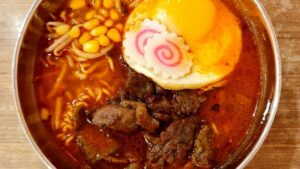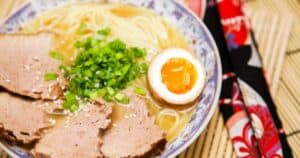Few things are as disappointing as watery ramen. The diluted broth that fails to cling to each noodle can leave you wishing your bowl packed more flavor. But don’t ditch the noodles just yet!
With a few simple tricks, you can easily whip up restaurant-quality ramen with a rich, concentrated broth. The secret lies in building a strong foundation with your broth, adding umami-rich ingredients, and cooking noodles separately from the liquid.
Follow the tips in this article to unlock the secrets of creating next-level ramen with satisfying, non-watery results every time. We’ll cover troubleshooting watery broth, avoiding overcooked noodles, and garnishing each bowl to perfection.
Soon you’ll be slurping deeply flavored, lip-smacking ramen like a pro. So say goodbye to lackluster noodles and learn how to achieve the ultimate richness in every bowl!
Diagnosing the Issue: Why Ramen Ends Up Watery
Before fixing watery ramen woes, it helps to understand what causes them in the first place. Here are some common culprits behind a diluted broth:
- Using too much water when cooking the noodles
- Weakly flavored broth made without enough bones, meat, or aromatics
- Allowing noodles to overcook and absorb too much liquid
- Failing to skim fat and impurities from the broth surface during cooking
- Not cooking the broth long enough to develop layered flavors
- Diluting broth with plain water before serving
Luckily, with a few strategic tweaks to your ramen cooking method, you can avoid these pitfalls and achieve an ultra-rich and concentrated broth every time.
Start with a Strong Broth Foundation
Achieving next-level ramen is all about the broth. Follow these tips to build a flavorful base:
- Simmer bones for hours: Pork, chicken, or beef bones supply rich flavor. Simmer for 4-6 hours minimum to extract marrow.
- Include aromatic veggies: Onion, garlic, ginger, and leeks add depth.
- Skim regularly: Clear fat and impurities from the surface to keep broth pristine.
- Season judiciously: Add soy, miso, etc. sparingly to avoid over-salting.
- Keep cooking times long: Extended simmering concentrates flavors.
Taking the time to coax out intense, layered flavors from bones and aromatics pays dividends in the end. This umami-rich broth is less likely to seem watered-down.
Cook Noodles Separately
For the perfect noodle texture, always cook ramen noodles separately from the broth. Here’s why:
- Keeps broth clarity intact since noodles won’t cloud it.
- Allows precise texture control based on cooking time.
- Prevents noodles from becoming bloated and waterlogged.
For fresh ramen noodles, boil briefly in water for 1-2 minutes only. For dried, follow package instructions, being careful not to overcook. Then add your perfectly cooked noodles to the broth just before serving.
Find the Right Broth to Water Ratio
When diluting broth with water, less is more. Follow this tip:
- Use a 2:1 ratio of broth to water. This concentrates flavor rather than weakening it.
For an even richer bowl, start with a small amount of broth and add more to taste as you eat. Toppings like meat and vegetables also help absorb excess liquid.
Cook in Small Batches
Cooking ramen in large quantities often leads to lackluster results. Instead, focus on smaller batches:
- 1-2 servings per pot keeps ingredient ratios balanced.
- Gives flexibility to customize broth for each bowl.
- Easier to achieve consistency between batches.
When craving ramen for a crowd, make broth in advance. Cook noodles to order and assemble bowls individually for maximum richness.
Strategic Ingredients for Boosting Flavor
Beyond bones and aromatics, incorporating ingredients packed with glutamates enhances umami for next-level depth. Consider adding:
- Dried mushrooms
- Ripe tomatoes
- Kombu seaweed
- Anchovies or sardines
- Miso paste or soy sauce
- Parmesan or pecorino cheese
A touch of these ingredients goes a long way in ramping up meatiness and savoriness for less wateriness.
Finishing Touches to Absorb Liquid
Lastly, finish each bowl with garnishes that soak up broth for the perfect slurping consistency:
- Soft-boiled egg
- Meat such as chashu pork or chicken
- Dry roasted seaweed
- Sauteed mushrooms
- Stir-fried vegetables
- Ramen noodles cooked al dente
These nourishing toppings allow you to savor every last drop of your labor-of-love broth.
Troubleshooting Watery Ramen
Follow this checklist if your ramen broth still seems thin and watery:
- Simmer bones longer to extract collagen and fat
- Reduce water added to broth to concentrate flavor
- Add meat or seafood for richness
- Cook noodles less to avoid bloating and absorption
- Garnish with egg, mushrooms, veg to soak up liquid
- Stir in miso paste, soy sauce to add flavor and saltiness
- Finish with cornstarch slurry to lightly thicken
With a few tweaks, you’ll be slurping deeply flavored, lip-smacking ramen in no time.
Frequently Asked Questions
Still seeking solutions for avoiding a watered-down ramen experience? Check out answers to some common questions below.
How can I thicken up my ramen broth?
- Simmer the broth for longer to reduce and concentrate flavors.
- Start with a higher ratio of meat and aromatics to water.
- Add collagen-rich ingredients like chicken feet or pig skin.
- Swirl in a cornstarch slurry at the end for a silky texture.
- Garnish bowls with ingredients that absorb liquid.
What is the ideal noodle to broth ratio?
As a general rule, aim for 150-200 grams of noodles per 500 ml broth per serving. Cook noodles separately al dente, and add broth to taste. Toppings can provide more absorption.
Should I cook noodles and broth together or separately?
Always cook noodles separately to prevent absorbing too much liquid. Cook in boiling water before combining with hot broth. This helps achieve the perfect texture.
How can I avoid watery broth when making ramen in big batches?
Make broth in a large batch, but cook noodles to order in individual portions. Avoid overdiluting broth, and use less water in each serving. Garnish each bowl to preference.
What are the best broth ingredients for rich flavor?
Prioritize pork or chicken bones, aromatics like onions and garlic, dried mushrooms, tomato paste, miso, kombu seaweed, and parmesan rinds.
Putting it All Together
Follow these tips for ramen with a rich, concentrated broth:
- Start with a strong bone broth seasoned with aromatics
- Cook noodles separately to perfect texture
- Use a 2:1 broth to water ratio
- Make broth and cook noodles in small batches
- Finish with umami-rich ingredients and absorptive garnishes
With practice, you’ll be able to avoid weak, watery ramen in favor of bowls with complex flavor in every slurp. Just take your time coaxing out flavors during cooking, and resist diluting flavors after the fact.
Soon you’ll be craving homemade ramen that’s deeply satisfying. Your tastebuds (and college budget) will thank you. So get cooking and master the art of ramen richness.





